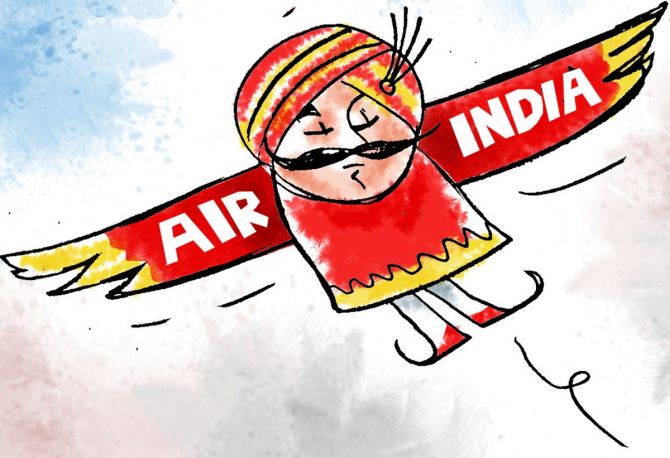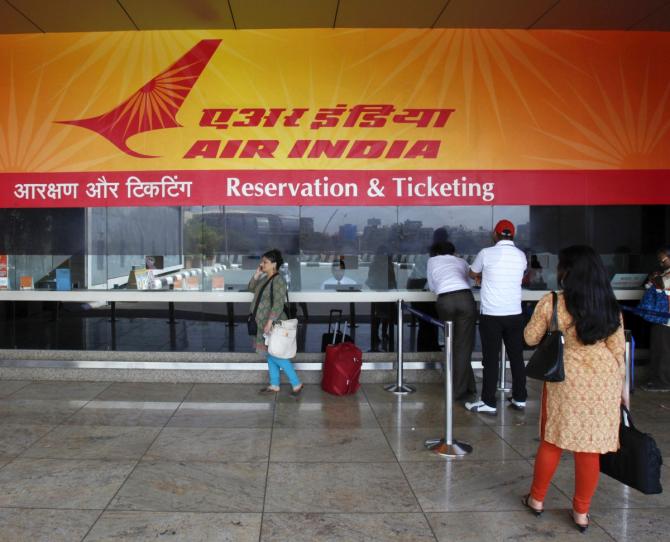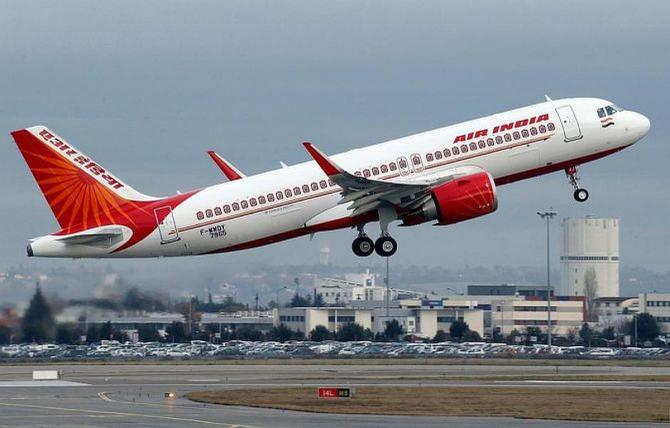 | « Back to article | Print this article |
'All they need is proper leadership.'

'Dear guests, this is your captain speaking. Welcome aboard this historic flight, which marks a special event. Today, Air India officially becomes a part of the Tata Group again, after seven decades... Welcome to the future of Air India! We hope you enjoy the journey. Thank you.'
This was the welcome announcement in all Air India flights on Friday, January 28, as the airline went 'back home' to the Tatas.
While regular fliers and employees heave a sigh of relief, the salt-to-software conglomerate has its work cut out for the coming years.
The airline that took off in 1948 was soon nationalised in 1953 under the Air Corporations Act, giving way to Air India-International and Indian Airlines operating on domestic routes.
The entities remained under the chairmanship of J R D Tata till 1978, when he was asked to resign by then prime minister Moraji Desai.
In the 30 years under Tata's chairmanship, Air India put India on the map by flying to virtually every country on the globe.
Ads featuring the brand's mascot -- the Maharaja -- nbuying carpets in West Asia and climbing the Alps in Switzerland came to be loved by fliers.

Air India's name became synonymous with trust, reflected in the numerous rescue missions that the airline headed, including rescuing over 120,000 Indian nationals from Iraq and Kuwait when the Gulf war broke out in 1990 -- a feat that finds space in the Guinness World Records -- and the more recent evacuation flights from the epicentre of the coronavirus outbreak, Wuhan.
"Air India was a fabulous airline under the chairmanship of J R D Tata and no one in the world could touch it. We were trained very well and were well looked after, and it was a joy to go on every flight," recalls F P Latouche, a former stewardess who started working for Indian Airlines sometime in 1956 and went on to serve onboard for over 30 years.
Hailing from an airline family, Latouche's sister, brother-in-law, niece and nephew all worked for Air India at different times.
Karen Ginwalla, Latocuhe's niece who started working for Air India in 1975, looks back at her five-year stint with pride.
In the age of bell-bottoms, the silk sari-donning air hostesses helped set the airline apart with their unmatched hospitality in the skies.
"I didn't know how to tie a sari in those days and it would take me an hour to get dressed for duty initially. It later came down to a few minutes," Ginwalla says.
"We worked with J R D Tata and it was an absolutely fabulous experience in terms of the way we were trained and the relationship between the crew. The standards fell later, but I hope now with the Tatas taking over, they'll improve," she says.
Things took a turn for the worse in the 1980s, when the civil aviation ministry appointed officials to run the airlines.
In 2007, with the merger of Air India and Indian Airlines, the entity became a loss-making venture, posting subsequent losses every year.
"From 1953-1978, Air India was still a government airline and was doing exceedingly well, which clearly means that it is not government ownership that comes in the way of efficient functioning of an airline but the kind of leadership that is provided," says Jitender Bhargava, former executive director, Air India and author of The Descent of Air India.

Going forward, Bhargava says the Tatas need to concentrate on three Ms to turn the airline around: Manpower, Machinery, and Marketing.
The much talked about excessive manpower is not an issue. "The Tatas need it. The pilots and aircraft engineers are trained, and the cabin crew are qualified," he says.
"All they need is proper leadership. A surplus in manpower gives them the scope of expanding their operations, thus optimising operations of men and machines."
"Air India was saddled with a bureaucrat. I am happy that the Government of India can no longer appoint a person of its choice to run it; the Tatas will run it professionally," says Bhargava.
A brand strategist who does not wish to be identified lists another alphabet, the three Es, for the Tatas to concentrate on: Engineering, Experience, and Eat.
He explains: The planes need to be refurbished and safe. The experience, right from the booking process to check-in and boarding, needs to be flawless, made easier and requires an overhaul.
The food has to be better and the liquor cannot be bad. Ambience alone does not make the experience.
"Air India was the symbol of Indian aspiration and was always more glamorous than its domestic counterpart since it represented foreign travel," says Samit Sinha, founder, Alchemist Brand Consulting, Delhi.
"While the brand has certainly eroded, there is a residual brand equity in the airlines," he says. However, no amount of imagery can restore a bad product, so the Tatas have a serious job at hand.
"Their product and all the services that come with it have to be top-notch," says Sinha.
"They are already very good with things like pilot experience and managing large-scale logistics, but it has to be very competitive in terms of punctuality, efficiency, and prices," he adds.
Still the only carrier with the country's name, which Sinha says is a huge opportunity, "it carries all the pride and emotion. It has a legacy. People do have some amount of affection left for the airline. It is common to hear that while they may not be the most punctual, they give greater on-board comfort. They are not mercenary in terms of leg room." He adds, "It has a lot of potential."
Latouche is confident the Tatas will build on that potential. "I'm sure they will bring it back to its previous glory."
Feature Presentation: Rajesh Alva/Rediff.com